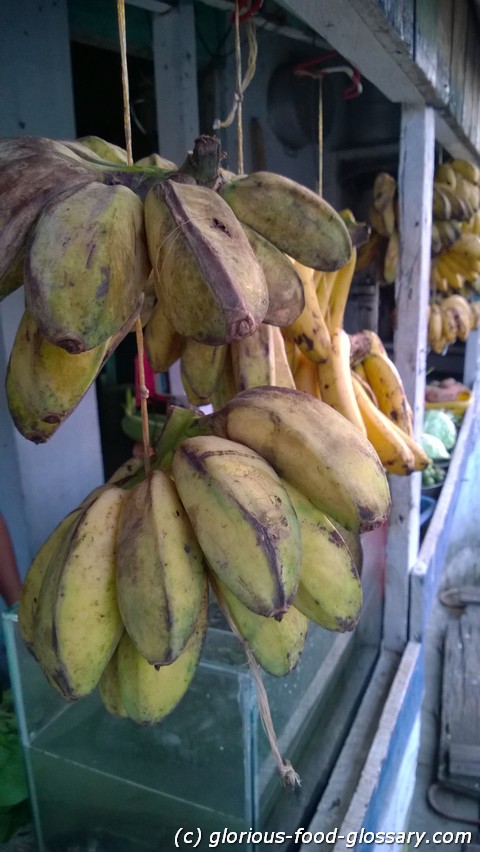Deutsch: Reife Saba-Banane / Español: Plátano Saba Maduro / Português: Banana Saba Madura / Français: Banane Saba Mûre / Italiano: Banana Saba Matura
Saging na Saba (Hinog) refers to the ripe version of the Saba banana, a type of cooking banana that is popular in the Philippines and other tropical areas. Unlike its unripe, green counterpart, the ripe Saba banana develops a sweeter flavor and softer texture, making it suitable for both cooking and eating raw. While still more starchy and less sweet compared to dessert bananas like the Lakatan or Cavendish, ripe Saba bananas offer a unique taste profile that is appreciated in various dishes.
Description
Ripe Saging na Saba exhibits a yellow skin, sometimes with black spots indicating full ripeness, and its flesh becomes softer and sweeter than when it is green. Despite being traditionally used for cooking due to its starchy nature, when ripe, it can also be enjoyed as a fruit snack, providing a different culinary experience. The natural sweetness and texture of ripe Saba bananas make them versatile for a wide range of recipes, from sweetened banana dishes to being incorporated into cakes and pastries.
Application Areas
In the culinary context, Saging na Saba (Hinog) is widely used in Filipino desserts and snacks. It's a key ingredient in dishes like "Minatamis na Saging," a sweetened banana dish cooked in syrup, and "Banana Cue," where ripe Saba bananas are skewered, coated in brown sugar, and fried. Ripe Saba bananas are also mashed and used in baking or as toppings for various sweet confections.
Well-Known Examples
- Minatamis na Saging: Ripe Saba bananas cooked in a mixture of water, brown sugar, and sometimes a touch of vanilla or pandan leaves.
- Banana Cue: Skewered ripe Saba bananas fried with caramelized sugar, making them a popular street food snack.
- Turon: Ripe Saba bananas with jackfruit wrapped in a spring roll wrapper and fried, often coated with a caramelized sugar glaze.
Treatment and Risks
Ripe Saba bananas are nutritious, providing dietary fiber, vitamins C and A, potassium, and other essential nutrients. However, as with any fruit, consuming them in moderation is advisable, particularly for individuals monitoring their sugar intake, due to their natural sugars. The preparation method, such as frying or adding sugar, can also add calories and should be considered in the context of an overall balanced diet.
Recipes
Simple Minatamis na Saging Recipe:
Ingredients:
- 6 ripe Saba bananas, peeled and sliced diagonally
- 1 cup brown sugar
- 2 cups water
- A pinch of salt
- A few drops of vanilla extract or a piece of pandan leaf (optional for added flavor)
Instructions:
- In a medium saucepan, combine water, brown sugar, and salt. Bring to a boil, stirring until the sugar is dissolved.
- Add the peeled and sliced Saba bananas to the syrup. If using, add vanilla extract or pandan leaf for extra flavor.
- Simmer over low heat for about 10 minutes, or until the bananas are tender and the syrup has thickened slightly.
- Remove from heat and let it cool. The bananas can be served warm or chilled, making a delicious dessert or snack.
Similar Terms or Synonyms
Saging na Saba (Hinog) might also be referred to as ripe cooking bananas or sweet plantains in some contexts, although Saba bananas have distinct characteristics and culinary uses compared to other plantains.
Summary
Saging na Saba (Hinog) plays a versatile role in Filipino cuisine, transitioning from a staple cooking ingredient when green to a cherished component of sweet dishes when ripe. Its unique flavor and texture when ripe make it ideal for desserts and snacks, offering a taste of Filipino culinary tradition that is both nourishing and satisfying.


